Visitor for Specializable Composition
Romel Rivera,
CTO, eKnowlogie
© 2001 Romel Rivera, All Rights Reserved
Abstract
The Visitor design pattern [Gamma95,
pp 331] is revisited. The proposed visitor is designed to support composite
structures which may be subclassified a posteriori in order to provide services
with increasing levels of specialization. The proposed visitor is designed
to support composite structures with both undistinguished and distinguished
relationships. The proposed visitor is complemented with a mechanism to support
both inherited (top-down) and synthesized (bottom-up) attribute flow during
visitation. This visitor has been generated automatically to support generic,
specific, and embedded language processing of Interpreter-Composite syntax-tree
structures in the automatic refactoring of web applications.
1. Visitor
The Visitor pattern [Gamma95, pp
331] represents operations to be performed on the nodes or elements
of a composite object structure. Visitor allows you to define new operations
without changing the classes of the nodes on which they operate. While the
visitor pattern represents a regression to functional decomposition by separating
state from functional responsibilities, it also restores the notion of OO
services to full stature; it promotes lightweight construction of classes
by allowing the encapsulation of services away from their client classes.
Consider a group of professors
and their students, who wish to spend a day at the museum. Rather than driving
themselves to the museum, they hire a shuttle. They hire a guide at the museum
to schedule tours and lectures for each individual, based on major, background
and preferences. Rather than adding the responsibilities of driving themselves
to the museum and teaching themselves, this composite structure of individuals
have made use of two visitors which provide these services for them.
Consider the class structure for
automotive parts manufacturing. Assume three operations need to be performed
on these parts, fabrication cost calculation, fabrication time calculation,
and compilation of raw material suppliers. The corresponding UML class structure
is shown below.
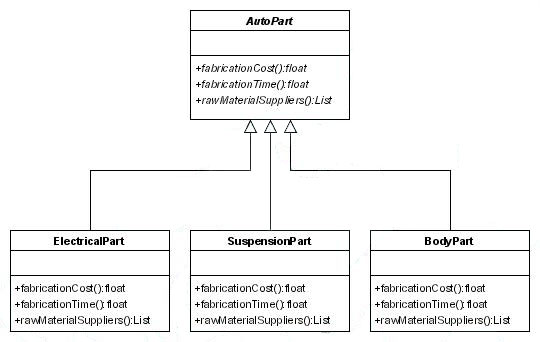
Figure
1. Composite Structure Operations Without the Visitor pattern
The Visitor
pattern allows us to separate and encapsulate all operations for calculating
fabrication cost, fabrication time and listing suppliers into servicing classes
called visitors.
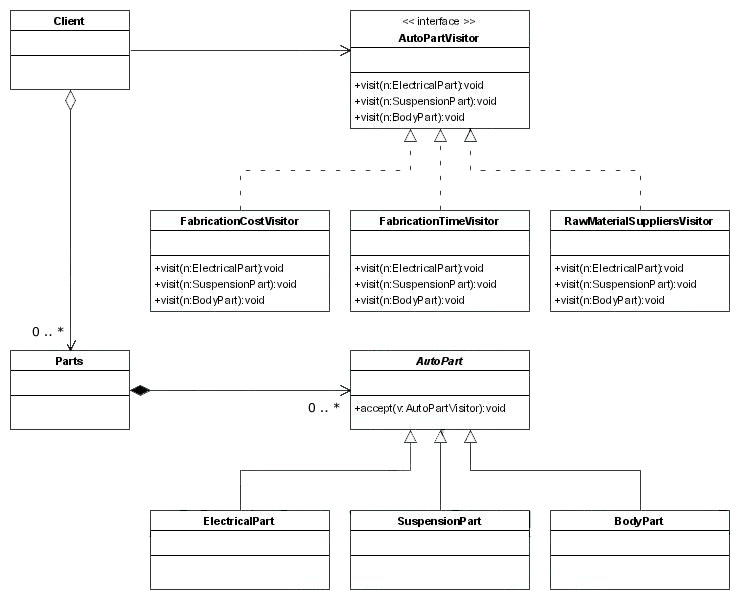
Figure
2. Composite Structure Operations with the Visitor pattern
Performing
these operations on the object structure changes as follows. Notice that a
return value has been added to the standard Visitor accept
signature in order to return a calculated value (attribute propagation through
visits is discussed in a subsequent section).
Without
Visitor |
With
Visitor |
| cost = electricalPart.
fabricationCost (); |
costObj = electricalPart.
accept (fabricationCostVisitor); |
| |
public class ElectricalPart extends AutoPart {
public Object accept (AutoPartVisitor v) {
return v. visit (this);
}
} |
Double Dispatch.
In OO languages, the method selected during invocation depends on the type
of the receiver or method qualifier (e.g. the type of "electricalPart"
above left). This is called single dispatch. In visitors, the operations performed
are selected through a double dispatch mechanism; first the type of the composite
object being visited (e.g. the type of "electricalPart" above right),
and second, the type of the visitor (e.g. the type of "v" which
is the type of "fabricationCostVisitor" above right). In the example
above, this ensures that in the signature for the visit invocation ("visit
(this)"), the parameter is not coerced to a superclass of "ElectricalPart"
and thus the signature can be properly matched. In other words, if instead
of "electricalPart. accept (fabricationCostVisitor)" we were to
say "fabricationCostVisitor. visit (electricalPart)", then we could
end up erroneously executing the visit operation for a superclass of "electricalPart".
This is because in single-dispatch OO languages, method parameters are not
resolved "polymorphically".
Reflective Visitor
[Blosser00]. Adding new concrete classes to a composite structure is difficult
with the Visitor pattern, because the Visitor interface and all the implementing
visitors must be modified. This can be avoided by having one single visit
operation for all node types which redirects the request to a private operation
for each specific type using reflection. This is a very flexible mechanism
that eliminates the need for a visitor interface though it still requires
that all node types serviced explicitly by the visitor be known inside the
given concrete visitor or its extensions thereof.
2. Motivation
for Visitor SC
The Visitor pattern is
designed to support operations or services on composite structures where all
the node classes are known a priori, and unlike the Reflective Visitor pattern,
it cannot be applied when these composite structures are later specialized
or subclassed to address foreign concerns. When servicing these specialized
composite structures, it may be important that each specialized concern provides
its own corresponding localized visitors, such that these local visitors can
be mixed and matched to constitute one single global visitor for the entire
composite structure. Consider the following examples:
-
In
automobile manufacturing, parts can be made from other specialized parts
from separate manufacturing divisions with unknown properties, fabrication
rules and materials. A body part, a dashboard, would include components
from the electrical and the electronics manufacturing divisions. Even though
these parts affect the fabrication cost and time of a body part, body manufacturing
does not have access to how those parts themselves are manufactured.
-
In
a company chart, separate divisions may have their own independent structures
with their own budgetary and profit calculation rules, and each such a division
should be able to devise, control and encapsulate such composition and operational
rules independently.
-
In
a syntax-directed language-processing development or refactoring environments,
it is very likely that sources in multiple languages need to be analyzed
and manipulated. In such situations, the following applies:
-
It
is crucial that generic, common operations can be applied to syntax-directed
composite structures and that such operations can be specialized for
specific language processing, otherwise the cost of developing these
environments would be prohibitive. For example, it is desirable to create
a generic pretty-printer which can be used to textually format abstract
syntax trees, regardless of the language in use. A generic pretty printer
can then be specialized to support specific-language formatting. It
is important that different versions or styles of generic and specific-language
formatting be mixed and matched. Another example is the generic construction
of control flow and data flow analysis operations.
-
This
also applies to embedded-language processing. Consider web application
where source code components are written in HTML, ColdFusion is embedded
in HTML, and SQL is embedded in ColdFusion. It is important that the
visitors for analyzing and transforming these syntax-directed composite
structures are specific to each language, and that these visitors can
be mixed and matched to create global visitors for the entire abstract
syntax trees.
Consider a previous alternative.
In Java Tree Builder [Palsberg00], JTB syntax trees are generated automatically
from Sun Java CC grammar specifications. The visitor pattern generated by
JTB requires the advance knowledge of all the node types in the syntax-directed
composite structure. This restricts language processing to one single language
and eliminates the possibility of building generic syntax-directed operations
to support specific-language processing. In addition, the JTB naming conventions
for the children of composite syntax tree nodes render the resulting code
unreadable.
The objective of the Visitor
SC pattern is to provide the following:
-
A
complete uniform visitation mechanism for all the nodes in the tree.
- Support for generic visitation.
-
Support
for specialized visitation using the strongly-typed node structure.
-
Separation
or modularization of the visitation according to specialization sub-domains
in the composite structure. Each specialization sub-domain will be independent
of the type structure from another specialization sub-domain. This way,
for example, a generic tree structure sub-domain can be used to implement
language-independent features and would not know the specific node structure
for specific languages, such as Java or C. Simmilarly, a generic control
flow tree structure layer could be implemented without requiring advance
knowledge of the control flow structure for Java and Pascal.
-
Specialization
Self-Containment. Insure that all nodes within a specialization sub-domain
are visited explicitly by the visitor operations for that domain, which
in turn can default to visitor operations of more generic sub-domains.
-
Isolate
composite structure traversal from operational concerns (see the Adaptive
Traversal pattern [Lieberherr00]).
-
Automatic
Generation. We also require that this pattern infrastructure can be
automatically generated.
3. Standardization
of the Visitor Pattern
We now standardize on
desirable characteristics of the Visitor Pattern.
Adaptive Traversal
Composition. The Composite pattern [Gamma95, pp 163], allows you to represent
hierarchies by providing uniform treatment of individual and composite objects.
An object in a hierarchy tree is a node. A composite node
is comprised of constituent nodes called children. In a composite
pattern structure, these children are indistinguished, meaning that
the role of one child in relationship to its parent is not differentiable
from the role of another child. The Interpreter pattern [Gamma95, pp 243]
is a Distinguished Composite pattern; that is, a Composite pattern
in which the children of a composite node may be dedicated to specific relationships
with their parent. In order to support generic visitation we require that
all the node classes in a distinguished or indistinguished composite structure
support adaptive traversal composition, by implementing Iterator
[Gamma, pp 257], or one or more structure-shy traversal mechanisms. In the
case of distinguished composition, the implementation of Iterator could be
supported with static "grammar" properties to properly select children
among all class fields (see also the Object Grammar pattern [Lieberherr97]),
and with the use of reflection. The implementation of Iterator and other traversal
interfaces in distinguished composition classes helps isolate traversal from
operational concerns (see the Adaptive Traversal pattern [Lieberherr00]).
Adaptive Traversal
Inside Visitors. Composite structure traversal is moved to the visitor,
because such traversal is an intrinsic part of the control flow of the operations
implemented in visitors, and not an inherent characteristic of the composite
class being serviced. In addition, visitors can be emplemented as extensions
of common traversal visitors. By using adaptive traversal patterns, traversal
is decoupled from the composite structure of the serviced classes and generic
traversal visitors can also be implemented.
Attribute Flow During
Visitation. Visitors are commonly used to affect the state of the visited
classes and / or retrieve computed values related to the structure. In addition
to visitors' being able to hold a state, visitors need a mechanism for the
propagation of visit values or attributes during structure traversal. Inherited
attributes are propagated top-down during traversal while synthesized
attributes are collected bottom-up during traversal. We
modify the visit signature to propagate inherited attributes through a visit
parameter, and collect synthesized attributes through a visit return object.
Single Name for Visit
Signatures. Instead of using different method names for visits to the
different classes in the composite structure (e.g. visitInteger
(Integer integer)), we use only
one single method name (i.e. visit)
overloaded for each class in the structure (e.g. visit
(Integer integer)). This gives us the flexibility to implement a visitor
interface with either multiple overloaded methods, one for each class, or
else with one single method which acts as a Facade [Gamma95] to redirect the
call using reflection to the multiple visit methods defined privately inside
the visitor [Blosser00].
4. A Visitor for
Specializable Composition
The solution is straight
forward. We break down Visitor into a visitor dispatcher which perfoms mediation,
and one or more visitor delegates which perform the actual visitation.
-
Divide
the composite structure into specialization subdomains. Order these subdomains
by increasing specialization; that is, such that if j < k, j does not
specialize k.
-
Create
three or more packages for specialization subdomain k: subdomaink.components,
subdomaink.visitor, and one or more subdomaink.specialops.
This is a likely organization that supports the separation and modularization
of these subdomains.
- The components
package contains all the comosite structure components for that subdomain.
- The visitor
package contains all the basic general visitor support interfaces and
classes for that subdomain, including general traversal visitors. This
package would be generated automatically.
- The specialops
packages contain visitor classes which perform specialized visitor operations
for such subdomain.
- Examples:
-
For
automotive parts, this could produce parts.electric.components,
parts.electric.visitor,
and specialops
parts.electric.cost and
parts.electric.suppliers.
-
For
a language processing environment, this could produce
lang.generic.syntaxtree,
lang.generic.visitor,
lang.generic.formatter,
for the generic subdomain, as well as
lang.html.visitor, lang.html.syntaxtree,
and lang.html.formatter
for the Html subdomain.
- Separate the composite
structure classes for all the nodes in subdomain k.
-
Create
a visitor interface ikVisitor which contains a visit
(NodeType) method for each concrete and non-concrete node type
in k. By requiring all subdomain k nodes to be visited within this subdomain,
we make the subdomain self-contained and can be manipulated without requiring
any specialization from a higher subdomain.
-
Support
the subclassing or specialization of each visitor subdomain so that a given
visitor pattern can be produced as a collection of the subclasses of choice
for each visitor subdomain. Otherwise, higher subdomain visitors would have
to commit to the implementations of lower subdomains, which can be overcome
only through a degradation in the modularity of the Visitor SC architecture.
For Java, the Visitor SC pattern is created by providing two implementations
of ikVisitor: kVisitorDispatcher and kVisitorDelegate.
kVisitorDispatcher provides the role of a monolithic visitor (e.g. kVisitorDispatcher
extends k-1VisitorDispatcher implements ikVisitor) by extending
the Java single inheritance line through the ordered subdomains. The function
of kVisitorDispatcher is to simply transfer the visit requests to kVisitorDelegate
which performs the actual node visitations for all the nodes in the subdomain.
In other words, kVisitorDispatcher serves as a Mediator [Gamma95 pp 273]
for all subdomain visits which are then redirected to kVisitorDelegate which
performs the actual visits. These delegates also use the dispatcher to mediate
among themselves for subsequent visit request they generate during adaptive
traversal; that is, they pass visitor dispatcher to the accept operations
of the composite structure nodes, rather than passing themselves. Contrary
to the Facade pattern [Gamma95 pp 185], Mediator provides bi-directional
mediation and hides the delegation to the "concrete colleagues".
Rather than creating kVisitorDelegate as an implementation of ikVisitor,
kVisitorDelegate is created as an implementation of ikVisitorDelegate which
extends ikVisitor with DispatcherConnection, to support mediation.
-
Define
and implement an accept (Visitor v) method for each concrete
and non-concrete composite structure node class in the subdomain, where
Visitor is the name of the visitor interface for the first or lowest or
most generic subdomain in this pattern. This makes each subdomain self-contained.
Implement this accept method by allowing the node to be visited by the highest
(up to the current subdomain) visitor interface. With the single-dispatch
limitation in Java, invocations to the specific visitor subdomains in the
visitor ancestry must be made explicitly, as shown in the following example,
where k-1 and k-2 and (k-3 = lowest subdomain) are all the previous subdomains
of k. These coercions propiciated by the single-dispatch limitation can
be eliminated using reflection, as shown in a subsequent section.
public void accept (Visitor v) {
if (v instanceof ikVisitor) ((ikVisitor) v). visit (this);
else if (v instanceof ik-1Visitor) ((ik-1Visitor) v). visit (this);
else if (v instanceof ik-2Visitor) ((ik-2Visitor) v). visit (this);
else ((ik-3Visitor) v). visit (this);
}
-
Insure
that kVisitorDelegate requests tree nodes to visit its dispatcher and not
itself. That is, invoke treeNode. accept (dispatcher); instead of "treeNode.
accept (this)".
-
A
dispatcher reference should always be represented with the type of the super
interface visitor, that is, ikVisitor when k = bottom or most generic subdomain.
This is to make sure that all specialized visitors extending the visitor
dispatcher are available to the tree nodes.
-
Now
you can construct a visitor with this delegate: myVisitor = new kVisitorDispatcher
(new kVisitorDelegate (), new k-1VisitorDelegate (), etc);. This allows
you to plugin and play the visitors of your choice for each layer in the
tree. Externally this visitor is referenced as myVisitor, internally (inside
the Visitor EST architecture) through the delegates' dispatcher reference.
-
Alternative:
Conversion of the dispatcher-delegate organization to a monolithic visitor.
Notice that a visitor delegate can also function as its own dispatcher simply
by setting its visitor dispatcher to itself, thus providing additional flexibility
in the creation of these components. Because of this, a visitor should always
be written as a visitor delegate as follows:
- Create kVisitorDelegate
implements ikVisitorDelegate.
- Make the default
dispatcher for kVisitorDelegate be itself.
- Alternatively,
turn this visitor delegate into its own dispatcher (i.e. a monotlithic
delegate visitor which we now rename "kVisitor") by letting
the delegate also extend the previous-layer dispatcher: kVisitor extends
k-1VisitorDispatcher implements ikVisitorDelegate. This allows you to
construct a visitor as follows: myVisitor = new kVisitor (new k-1VisitorDelegate
());. Again, externally this visitor is referenced as myVisitor, internally
through the delegates' dispatcher reference.
- While providing
monolithic visitor delegates is more user-friendly for the casual user,
it is also more restrictive. When using monolithic delegates, alternative
cascading constructors should be in place to allow each subdomain to
replace visitor delegates for all of the previous subdomains.
-
Alternative:
Creation of a monolithic visitor without the dispatcher-delegate organization.
Create an implementation "kVisitor" for interface "ikVisitor":
"kVisitor implements ikVisitor". If kVisitor is not the initial
or lowest layer, then also extend the implementation of your choice "jVisitor"
for the visitor interface "ijVisitor" of the previous layer "j":
"kVisitor extends jVisitor implements ikVisitor".
Layered
Architectural Decomposition
In the following
UML diagrams, design patterns are shown as stereotypes. Notice that
n-tier application architectures are typically layered across a functionality
axis (which makes applications more understandable to external
application clients), thus producing, for example, presentation, session
controller, model manipulation, and database engine layers. In addition
to such functional decomposition it is important to further enhance
reusability by breaking down functional layers across and implementation
axis. The following UML diagrams show three visitor implementation
layers with increasing specificity. The blue or bottom layer is the
domain-independent layer, next, the orange layer is the domain-specific
infrastructure layer, and finally, the burgundy layer is the
operation-specific layer for the implementation of specific operations.
The following UML class diagram shows the automatic construction phase
of the Visitor SC infrastructure.
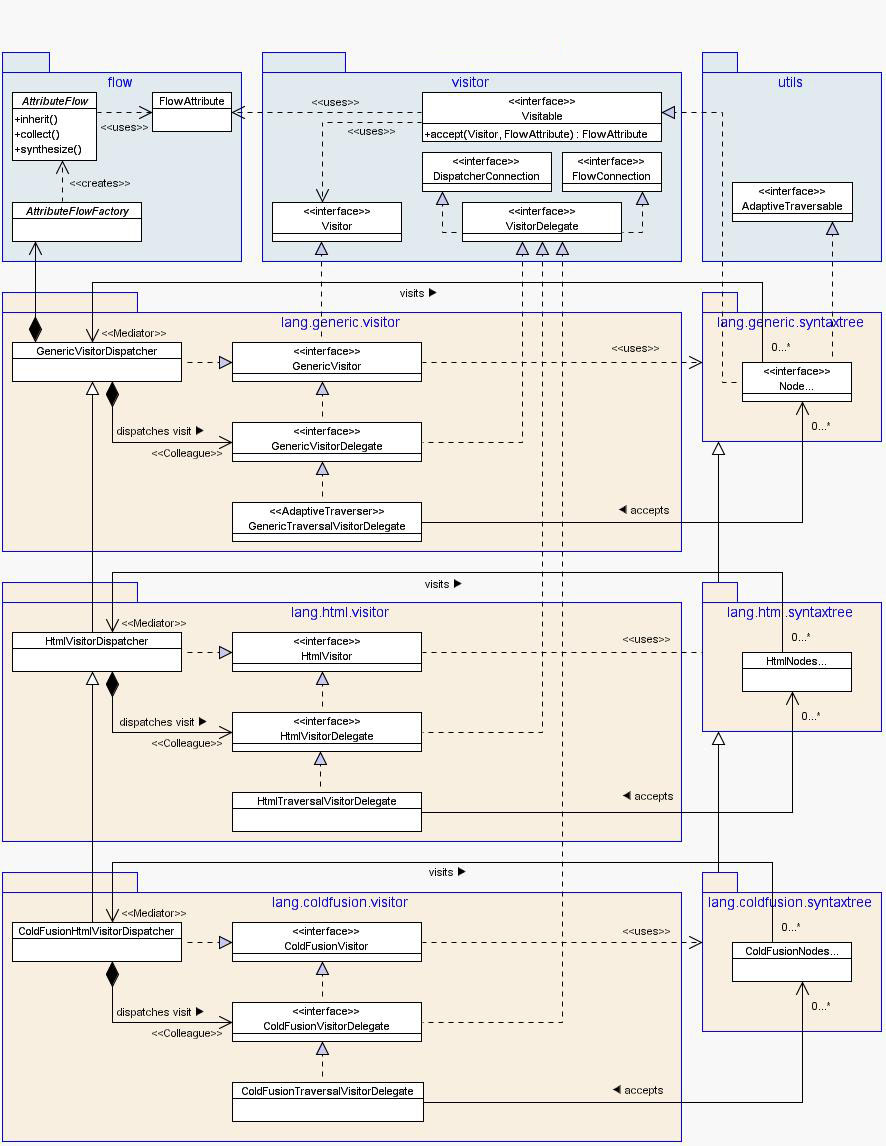
Figure
3. Automatic Construction Phase of Visitor SC
The following
UML class diagram shows the operation building phase. Notice that the "accepts"
association between the formatters and Node would be more accurately represented
as an association between the traversal delegates and Node which is then inherited
by all subclasses, but it was represented instead between the subclasses just
to more explicitly display the implementation responsibilities for these operations.
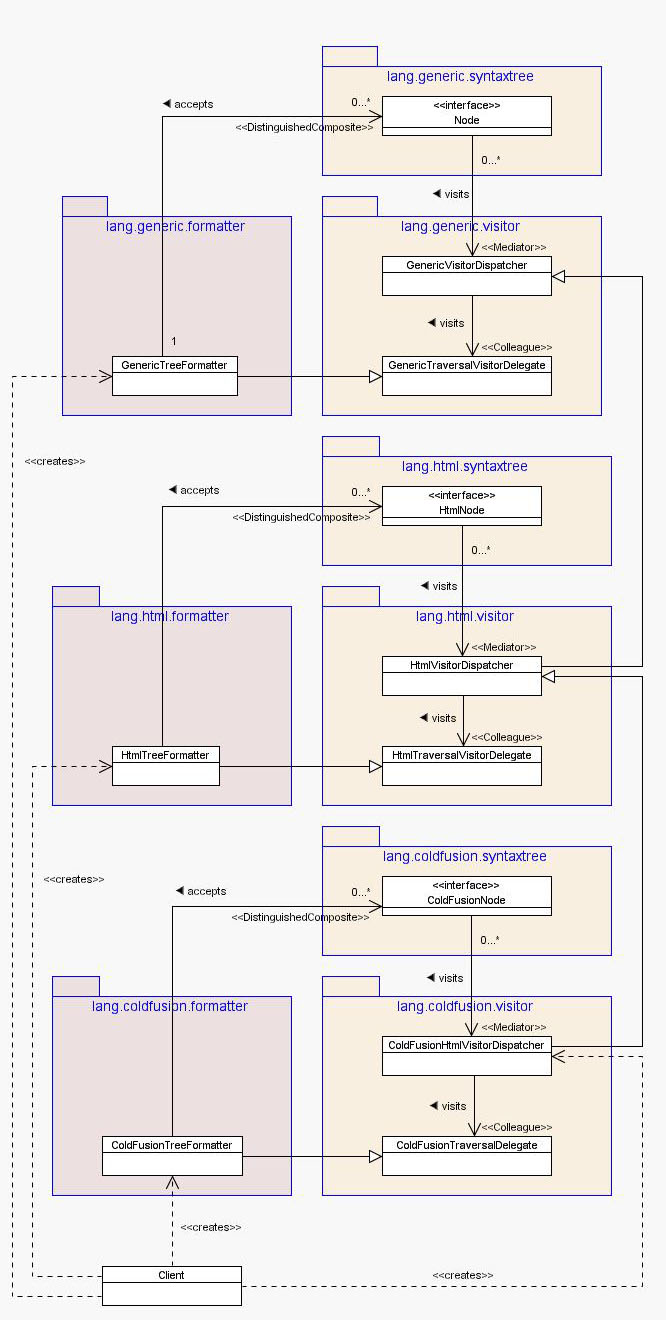
Figure
4. Manual Operation Building Phase with Visitor SC
5.
Complementing Visitation with the Attribute Flow Factory Pattern
There are three ways to
accumulate state during visitor-driven operations:
A visit
may be qualified by visit-based state information called attributes.
Attributes can be inherited by visits in a top-down fashion or synthesized
by visits in a bottom-up fashion. Inherited attributes can be passed on a visit
by adding an additional visit parameter. Synthesized attributes can be collected
from visits by receiving them through the visits' result value. In order to
support attribute flow, we require that a visit signature has an additional
inherited attribute parameter and a result value for synthesized attributes.
Examples
of synthesized attributes include:
- Evaluating syntax tree
expressions from the values of its subexpressions.
- Producing a formatted
textual representation (pretty print) of a syntax tree.
- Collecting total expenditures
for departments or divisions in a company chart.
- Calculating minimum manufacturing
time for automotive parts.
Examples of inherited attributes
include:
- Distributing a maximum
allocated budget throughout departments and divisions of a company.
- Allocating manufacturing
deadlines for automotive parts.
We can equip
a visitor dispatcher with an Abstract Factory [Gamma95 pp 87] for attribute
flow, so that each visit can create an attribue flow object which can manage
its attribute flow requirements. This way, we isolate all general attribute
flow concerns from each visit eliminating redundancy and flow dependencies thus
promoting reusability of the visitor based on changing flow requirements.
The abstract
attribute flow class would be initialized with the inherited attribute for the
visit along with the node being visited. It would have an inherit operation
to pass a new inherited attribute to the node's children visits, it would have
a collect operation to collect synthesized operations from the node's children
visits, and it would have a synthesize operation to produce a synthesized result
for the visit in question. Notice that the visited node itself is also passed
to the attribute flow object during initialization in order to support attributes
that may be partially derived from the node and in order to support attribute-based
modifications to the state of the node. In addition, the class Attribute can
be defined as a property hash table. For example, an attribute flow extension
for a syntax tree formatter would implement String concatenation for its synthesized
attributes. Consider the following visit to the super node in a hierarchical
structure:
public Attribute visit (Node n, Attribute inherited) {
AttributeFlow flow = getFlowFactory (). createFlow (n, inherited);
AdaptiveTraversal traversal = n. traverseChildren (n);
while (traversal. hasNext ()) {
flow. collect (((Node) traversal. next ()). accept (dispatcher, flow. inherit ()));
}
return flow. synthesize (n);
}
Notice that node traversal
has been separated from the visit and encapsulated into a structure-independent
traversal mechanism. In its simplest form, as it may apply to true indistinguished
composite structures, traversal can be implemented with Iterator. In distinguished
composite structures, such as Interpreter, where children nodes may be distinguished
with dedicated names and for dedicated purposes, variations of the AdaptiveTraversal
patterns may be implemented, as explained earlier. Adaptive traversal allows
generic support of distinguished composites, such as syntax trees.
Notice also that the mechanics
of attribute flow propagation and manipulation have also been separated from
the visit itself and into encapsulated attribute flow strategies. This eliminates
the redundancy of repeating these flow mechanics in every single visit, and
increases the reusability of the visit. For example, consider the implementation
of a concrete attribute flow named a StringCollector, which would return a
concatenation of all strings collected during the visit. If StringCollector
were to be used as the concrete AttributeFlow in the visit above, such visit
could be used without change as the generic default visit in a syntax tree
formatter or pretty printer.
6. A Reflective
Visitor SC Pattern
Having all nodes in a
subdomain always visited by the local visitor delegate for that domain offers
many advantages. In visitor-intensive applications, it is convenient to make
sure that the implemented operations are localized, in order to insure that
a decision has been made about the processing of each node in the subdomain,
and visitor interfaces provide such reassurances. For example, in language
processing, it is convenient to know that all the decisions regarding name
resolution for embedded SQL are being made the SQL visitor and not passed
on to the enclosing ColdFusion visitor. However, if we remove the contractual
requirement that all nodes in every subdomain must be visited by its local
delegate, we can replace all single-dispatching sequences in the Visitor SC
pattern with one multiple dispatching operation using reflection. The accept
method would no longer be necessary but left in the pattern for consistency
with future versions of a visitor pattern. Coercions can be eliminate and
the accept method implemented as prescribed in the original Visitor pattern.
Only one visitor dispatcher class, independent of any composite structure,
would be needed, and with one single visit operation, as follows:
public void accept (Visitor v) {
v. visit (this);
}
public class Visitor {
...
Vector orderedDelegates = new Vector ();
public Attribute visit (Object node, Attribute inherited) {
Object [] parameters = new Object [] {node, inherited}
Class [] parameterClasses = new Class [] {o. getClass (), Attribute. class};
ListIterator it = orderedDelegates. listIterator ();
while (it. hasNext ()) {
try {
Object delegate = it. next ();
Method delegateVisit = delegate. next (). getClass (). getMethod ("visit", parameterClasses);
return (Attribute) delegateVisit. invoke (delegate, parameters);
}
catch (NoSuchMethodException e) { }
}
throw new Error ("No such visitor method found");
}
}
The following figure shows the architecture
for the automatic construction phase using reflective multiple dispatching.
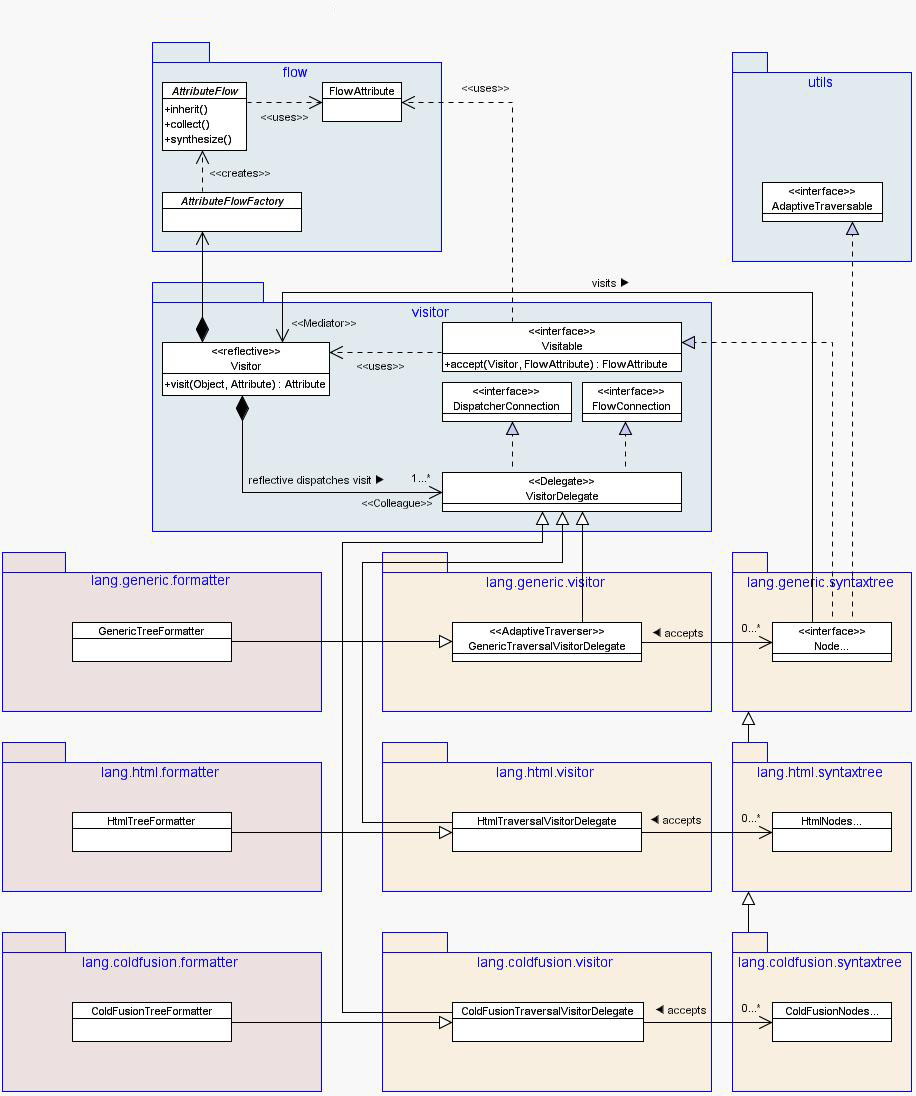
Figure
5. The Automatic Construction Phase Using Reflective Dispatching
Notice
how the construction phase has been simplified by using reflection, though
must of the simplification comes from the elimination of the contractual interfaces
for subdomain visitors.
6. Experience
The Visitor SC pattern
as described in this paper has been used extensively as the major infrastructure
for the construction of operations over embedded syntax tree structures in
the eKnowlogie language processing environment. The classes and organization
presented under the automatic generation phase is generated automatically,
including syntax tree classes from language grammars and including support
for adaptive traversal and the abstract flow factory. This Visitor SC pattern
has provided support for convenient generic and embedded multi-language processing,
as needed for the ColdFusion to Java J2EE Migrator refactoring technology.
ColdFusion applications are web applications written in Html with embedded
ColdFusion which in turn contains embedded SQL.
7. References
[Blosser00] Jeremy Blosser.
The
Reflective Visitor Design Pattern. JavaWorld, July 14, 2000.
[Cooper98] James W. Cooper.
The Design Patterns
Java Companion . IBM Watson Research Center, 1998.
[Gamma95] Erich Gamma,
Richard Helm, Ralph Johnson, John Vlissides. Design
Patterns, Elements of Reusable Object-Oriented Software. Addison-Wesley,
1995.
[Grand98] Mark Grand.
Patterns
in Java, Volume 1 . John Wiley & Sons, 1998.
[Grand99] Mark Grand.
Patterns
in Java, Volume 2. John Wiley & Sons, 1999.
[Hillside] Patterns
Library.
[Huston02] Vince Huston.
Design Patterns
, see Abstract
Factory, Composite,
Facade, Interpreter
, Iterator,
Mediator
, Visitor
. Feb 11, 2002.
[Lieberherr97] Karl Lieberherr.
The
Object Grammar Pattern . Patterns for Adaptive Programming, Jan 5, 1997.
[Lieberherr00] Karl Lieberherr.
The
Adaptive Traversal Pattern . Patterns for Adaptive Programming, Sept 15,
2000.
[Moore00] John Moore.
Delegation vrs Inheritance
. jGuru, March 23, 2000.
[Palsberg00] Jens Palsberg,
Kevin Tao, Wanjun Wang. Java Tree
Builder. Evolution of Software via Adaptive Programming, DARPA EDCS. Purdue
University, August 6, 2000.
[Sintes01] Tony Sintes.
True
Delegation , JavaWorld, Sept 14, 2001.




